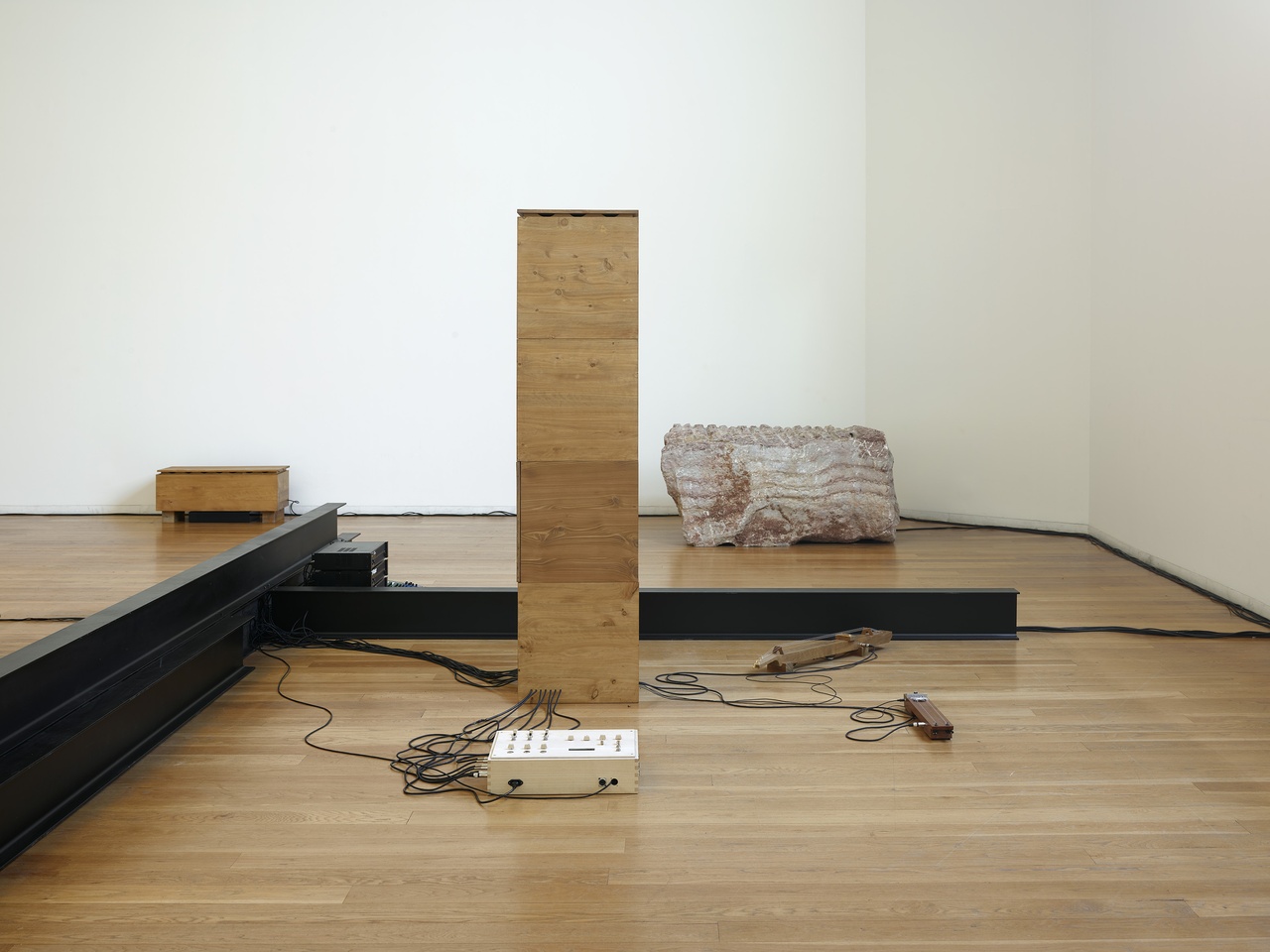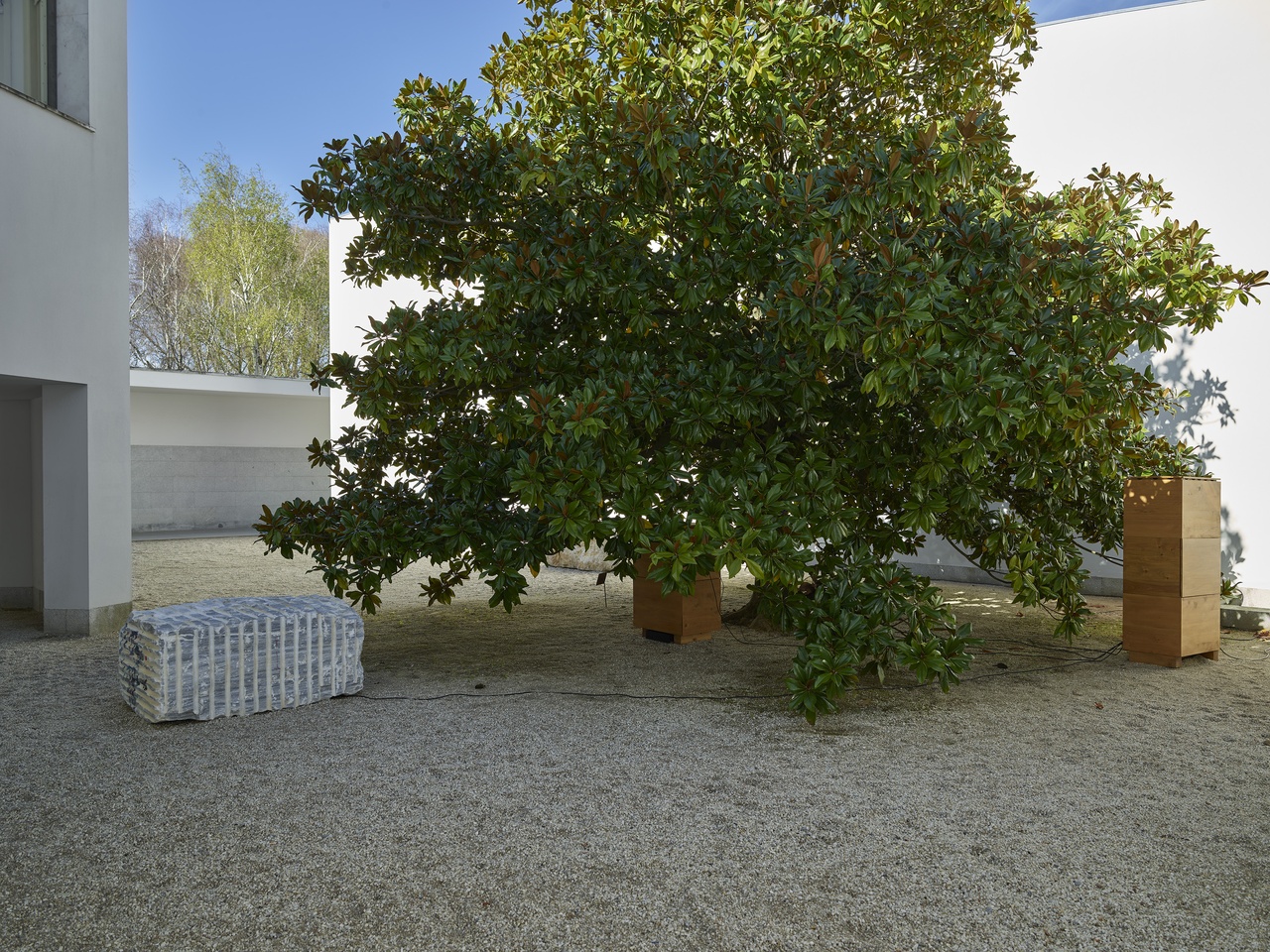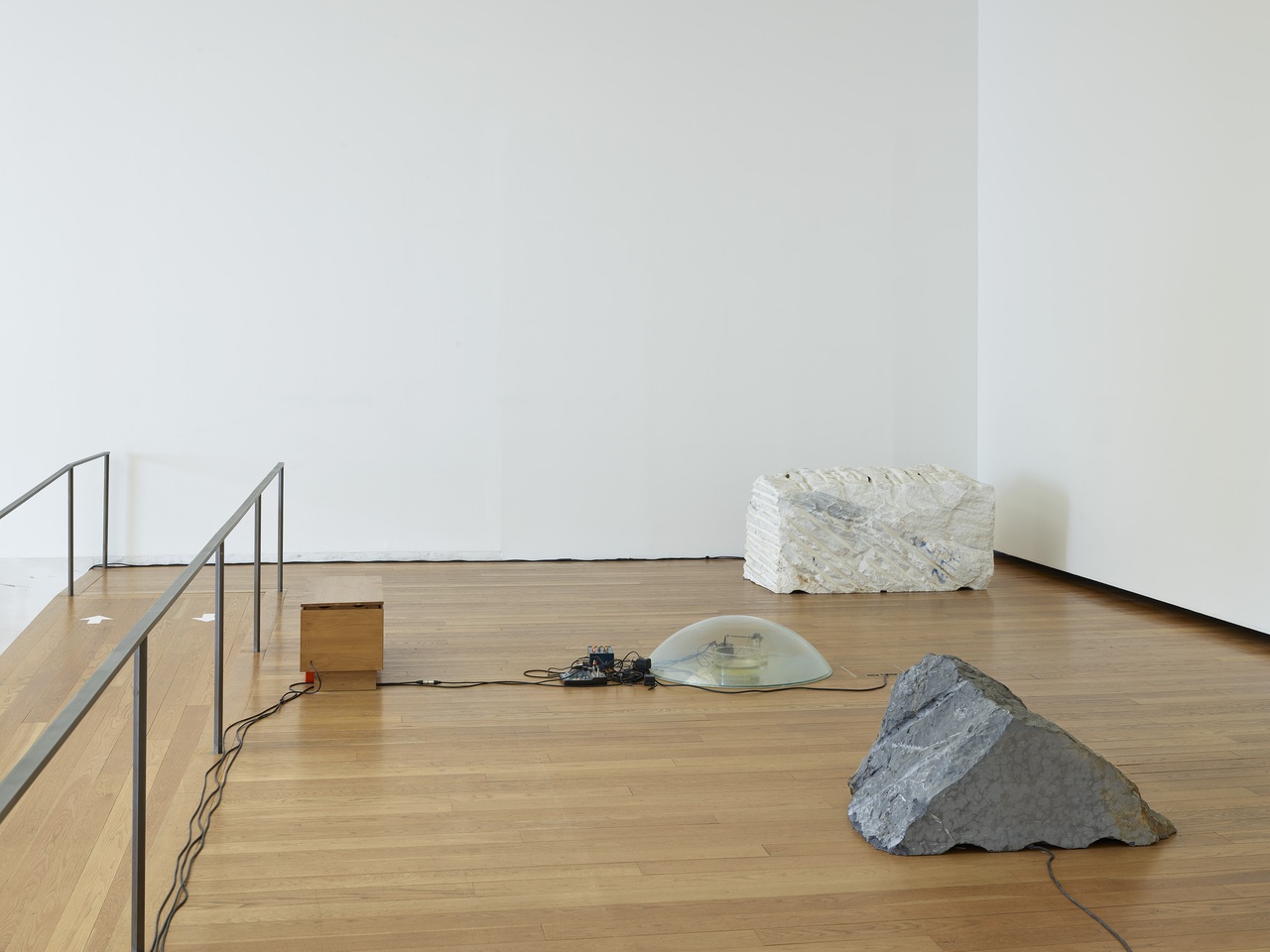WHAT THE SOUNDS DO NOT TELL US Magnus Schaefer on Tarek Atoui at Serralves Museum of Contemporary Art, Porto

“Tarek Atoui: Waters’ Witness,” Serralves Museum of Contemporary Art, Porto, 2022, installation view
Tarek Atoui’s exhibition “Waters’ Witness” rings with myriad layers of sound – spectral scraping and glassy string drones punctuated by occasional thuds or voices emerging from below the surface of the mix. Based on processed field recordings from the ports of Abu Dhabi, Athens, and Porto, combined with live and prerecorded sounds from several self-built electroacoustic instruments, this audio material serves as the connecting agent for different sites, materials, temporalities, and modes of interaction. Three types of sculptural objects function as “speakers,” or rather resonating bodies, for an ambient soundscape that ebbs and flows between them: horizontal metal beams on the floor, rough-hewn marble blocks, and wooden columns with drawers containing compost. The bulk of the exhibition is installed in a bright, spacious gallery in Serralves’s main museum building, with additional components located under a magnolia tree just outside the museum entrance and beside a pool at the far end of the surrounding park, near a pasture where sheep and cattle graze. In these different settings, Atoui’s composition mingles with the reverberant acoustics of the exhibition space and environmental sounds such as footsteps on gravel, the rustling of leaves, and birdsong.
With the resonating objects loosely distributed throughout the gallery, the sound seems to come from everywhere and nowhere at the same time, creating a diffuse acoustic environment that has a distinct perceptual presence but does not become aggressive or overwhelming. The overall sound is characterized by the spectral quality of processed field recordings: acoustic in origin, interspersed with some recognizable snippets, such as traffic noise or voices, but difficult, if not impossible, to identify exactly. In addition to these sounds, there are delicate clinks from a motorized contraption that rotates a small chain over two bowls of water, with the erratically recoiling chain producing a slightly irregular rhythm. Another motorized instrument generates a scraping noise by slowly dragging a piece of stone across the rough surface of a stone tablet. A third device consists of a wooden box with an intermittently spinning bar whose movement creates brief sequences of muffled thuds. The installation also includes a group of string instruments that does not produce live sound in the gallery but can be heard in the recorded composition.

“Tarek Atoui: Waters’ Witness,” Serralves Museum of Contemporary Art, Porto, 2022, installation view
As I roamed across the two levels of the open gallery, among the objects, instruments, and playback equipment, my first association was with strolling through an artificial landscape, echoing with the experience of wandering through the surroundings of the museum, where the satellite components of the exhibition blend in with the park landscape. A photograph by Atoui’s longtime artistic collaborator Alexandre Guirkinger, which is reproduced in the exhibition brochure, suggests a less pastoral perspective, though. It shows pieces of driftwood at the Leixões harbor in Porto, with the rigid lines of an enormous metal bridge looming in the background. Rather than a landscape, the installation evokes objects and detritus accumulating in the boundary zones of industrial and natural activity.
Atoui’s exhibition functions as an assemblage, both literally and figuratively. It links the electronically transduced and processed sounds of activities at faraway harbors to the physical properties of resonant bodies of metal, stone, and wood. The “there” of the ports is connected to the “here” of the exhibition, which is itself distributed across three distinct sites on the Serralves campus, and the “then” of the field recordings is joined to the “now” of the live instrument sounds, the bodies moving through the exhibition space, and the acoustic properties of the surroundings. Sound brings and holds these different elements together, across different sites, temporalities, and dichotomies of found and made elements. Sound, as physical vibration, affects and is affected by the resonant sculptural objects, the bodies of exhibition visitors, and the environments in and around the museum. The assemblage also extends into the social through Atoui’s collaborations with the sound artist Eric La Casa (who worked with Atoui on the field recordings), with several instrument builders, and with local musicians, artists, and art students, who perform in and with the installation on several occasions during the course of the exhibition. Their activities join those of the waves, boats, port workers, metal bars, marble, wood, microorganisms in the compost, vibrating strings, electrical currents representing the sound signals, and rustling leaves of the trees under which parts of the exhibition are installed. Yet the specific and asymmetrical ways in which the various elements of this assemblage relate to each other tend to remain oblique.

“Tarek Atoui: Waters’ Witness,” Serralves Museum of Contemporary Art, Porto, 2022, installation view
The exhibition title, “Waters’ Witness,” suggests a kind of documentary practice through acts of being present, observing, and gathering evidence. The accompanying brochure explains that the field recordings are part of Atoui’s ongoing project I/E (Infinite Ear), for which he captures sounds in different port cities to “reveal and single out the multiple layered strata of every location in a process akin to sound archaeology.” [1] This collection comprises “recordings of underwater areas, human and industrial activities, nature reserves, fish markets, military bases, [and] oil tankers.” To Atoui, recordings from different locations suggest specific perceptual qualities, with the Athens and Porto harbors appearing “oneiric,” characterized by nebulous, thick, and misty sounds, while “Abu Dhabi was telluric, with bright, sharp and clear sounds.” Drawing a connection between the perceived qualities of sounds and sculptural materials, Atoui mapped the recordings from Abu Dhabi to the steel beams, the sounds from Athens to the marble blocks, and the sounds from Porto to the wooden columns, perhaps suggesting parallels between the resonant properties of the sculptural materials, which were sourced from the three locations, and the qualities of the original sound material. The artist’s approach proposes a subjective taxonomy of location-specific sound that is based on perceptual and aesthetic qualities rather than a distanced gesture that might aim to signal some sort of objectivity. Following this line of thought, the phenomenological richness of the soundscape in “Waters’ Witness” brings to the fore speculative affinities and relationships between sounds, materials, and activities that a more traditional documentary account of these ports might not register.
What this perspective largely obscures, however, are the particular socioeconomic conditions that shape life around the ports from which the field recordings originate. Without the wall text and the exhibition brochure, the sources of the recordings would have been impossible to decipher. In terms of site-specificity, the Porto harbor, located a 15-minute drive from the museum, is an obvious choice. But it remains unclear what exactly connects this port to the two other locations. Ports are key infrastructural nodes for facilitating and regulating the circulation of labor and goods across international borders, and they are places where people perform all kinds of different work. As the aforementioned photograph of Leixões harbor suggests, ports are also sites where industrial-scale machinery and processes intersect with and disrupt marine ecosystems. According to the exhibition brochure, Atoui records the sounds of “industrial, human, and ecological activities.” But equating the witnessing of life in and around water at different ports with assembling oblique traces of various activities risks obfuscating the conditions under which these activities take place or even why ports are distinct from other contemporary infrastructures. In other words, what is it about ports, or these ports, that warrants attention? What might account for the fact that the acoustic quality of the Abu Dhabi port is different from that of the harbors in Athens or Porto? How are migrant workers, gigantic vessels, ocean waters, self-built instruments, compost, and exhibition visitors at Serralves differently implicated in the process of witnessing? “Waters’ Witness” makes a case for considering the relations between the heterogeneous elements it assembles in terms of their rich phenomenological and aesthetic dimensions, but it does so at the possible cost of losing track of the material, sociohistorical conditions these are grounded in.
“Tarek Atoui: Waters’ Witness,” Serralves Museum of Contemporary Art, Porto, February 24–August 28, 2022.
Magnus Schaefer is a historian and curator with a research focus on digital sound synthesis.
Image credit: Courtesy of Venus Over Manhattan, New York
Note
| [1] | This and all other direct quotes are from “Tarek Atoui: Waters’ Witness / O testemunho das águas,” exh. brochure (Porto: Serralves Museu de Arte Contemporânea, 2022). |
